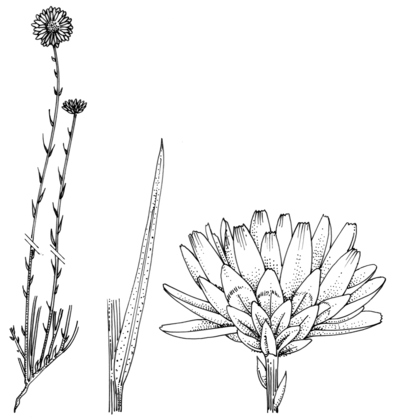Common name: Chamomile Sunray
Rhodanthe anthemoides (Spreng.) Paul G.Wilson APNI* Synonyms: Helipterum anthemoides (Spreng.) A.Cunn. ex DC. APNI*

Description: Erect bushy herb with many slender stems arising from a perennial rootstock; stems to 30 cm high, glabrous to sparsely and finely pubescent.
Leaves often crowded, thick, linear to narrow-oblong, c. 10 mm long, 0.5–2 mm wide, apex acute, scabrous-ciliate, with sessile sunken globose glands.
Heads solitary, terminal, broad-turbinate to hemispherical, c. 5 mm long; outer and intermediate involucral bracts broad-elliptic, ciliate, pale brown with purple midrib; inner involucral bracts with an elliptic white lamina c. 6 mm long. Florets numerous. Corollas c. 6 mm long.
Achenes narrow-cylindrical, c. 2 mm long, silky-pilose; pappus equal to corolla, terminal cilia clavate, persistent.
Flowering: summer.
Distribution and occurrence: Grows predominantly in montane rocky areas, often on sandy soils; widespread.
NSW subdivisions: NC, CC, NT, CT, ST, NWS, CWS, SWS, NWP
Other Australian states: Qld Vic. Tas.
Text by Paul G. Wilson
Taxon concept: Flora of NSW 3 (1992)
APNI* Provides a link to the Australian Plant Name Index (hosted by the Australian National Botanic Gardens) for comprehensive bibliographic data
***The AVH map option provides a detailed interactive Australia wide distribution map drawn from collections held by all major Australian herbaria participating in the Australian Virtual Herbarium project.
|


